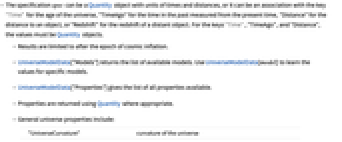UniverseModelData[spec]
returns properties of the universe based on the default model at specification defined by the time after the Big Bang, the distance to the comoving object, or the redshift of such an object.
UniverseModelData[spec,model]
returns properties of universe model at spec.
UniverseModelData[spec,property]
returns the specified property at the time or distance spec.
UniverseModelData[spec,property,model]
returns the specified property at the time or distance spec for the universe model.


UniverseModelData
UniverseModelData[spec]
returns properties of the universe based on the default model at specification defined by the time after the Big Bang, the distance to the comoving object, or the redshift of such an object.
UniverseModelData[spec,model]
returns properties of universe model at spec.
UniverseModelData[spec,property]
returns the specified property at the time or distance spec.
UniverseModelData[spec,property,model]
returns the specified property at the time or distance spec for the universe model.
Details




- The specification spec can be a Quantity object with units of times and distances, or it can be an association with the key "Time" for the age of the universe, "TimeAgo" for the time in the past measured from the present time, "Distance" for the distance to an object, or "Redshift" for the redshift of a distant object. For the keys "Time", "TimeAgo", and "Distance", the values must be Quantity objects.
- Results are limited to after the epoch of cosmic inflation.
- UniverseModelData["Models"] returns the list of available models. Use UniverseModelData[model] to learn the values for specific models.
- UniverseModelData["Properties"] gives the list of all properties available.
- Properties are returned using Quantity where appropriate.
- General universe properties include:
-
"UniverseCurvature" curvature of the universe - Properties referring to an object seen at a distance
 that corresponds to a time
that corresponds to a time  after the Big Bang include:
after the Big Bang include: -
"AngularDiameterDistance" distance determined by angular diameter "ComovingDistance" distance measure not affected by the expansion or contraction of space "ComovingVolume" volume of space within the comoving distance "ConformalTime" time measure not affected by the expansion or contraction of space "DarkEnergyDensityRatio" ratio of dark energy density to the total energy density in the universe "Epoch" overall composition of the universe model "EventHorizon" maximum distance from which light emitted at a given time can reach the observer in the future "HubbleDistance" distance to objects receding from observer at light speed "HubbleParameter" rate of expansion of the universe model "LuminosityDistance" distance determined by luminosity "MatterEnergyDensityRatio" ratio of matter density to the total energy density in the universe "MaximumUniverseAge" maximum age the universe can ever reach "ParticleHorizon" maximum distance traveled by light from the Big Bang to a given time "RadiationEnergyDensityRatio" ratio of radiation density to the total energy density in the universe "RadiationTemperature" temperature of background radiation "Redshift" shift in wavelength due to expansion or contraction of space "ScaleFactor" change in distance due to expansion or contraction of space "TimeAgo" time in past measured from the present time "TotalObservableRadiusFraction" fraction of the universe seen out of total possible for all time "TransverseComovingDistance" comoving distance between two objects located at the same redshift - model can be specified by one of the available models, by supplying the parameters for the composition of the universe, or by supplying the model and the parameters that diverge from it.
- The default universe model is "LambdaCDM".
- Parameters include:
-
"HubbleH0" Hubble constant H "OmegaLambda" ratio of dark energy density to the critical density "OmegaMatter" ratio of matter density to the critical density "OmegaRadiation" ratio of radiation density to the critical density "OmegaK" ratio of curvature density to the critical density - All parameters refer to their values now.
- "HubbleH0" should be a Quantity with dimension of inverse time. All other parameters should be dimensionless or percentage quantities.
- Parameters should be supplied as an association.
- Calculations use the Friedmann–Lemaître–Robertson–Walker (FLRW) metric, the Friedmann equations, and the equations of state for the matter, radiation, and dark energy components.
Examples
open all close allBasic Examples (3)
Scope (7)
Applications (7)
Examine the expansion of the observable radius of the universe over time:
Discover the properties of a matter-dominated universe:
Explore how the uncertainty in the Hubble constant (![]()
![]() ) affects estimates of the background radiation temperature in the early universe:
) affects estimates of the background radiation temperature in the early universe:
Examine the effect of the Hubble constant value on the present-day particle horizon:
Discover when the background radiation temperature would have been 300 K:
Calculate the comoving distance to objects in the Virgo galaxy cluster:
Examine how they deviate with increasing distance:
Examine the variation of temperature in the cosmic microwave background (CMB) over time:
Possible Issues (5)
Specifications for universe composition should be positive numbers or percentages:
Components of the universe can sum to greater than unity:
Results are limited to at least ![]() seconds after the Big Bang:
seconds after the Big Bang:
All cosmological components plus the curvature should add up to one:
Missing components will be derived when curvature is included:
Use UniverseModelData[model] to help determine the best values to include:
Related Guides
History
Text
Wolfram Research (2016), UniverseModelData, Wolfram Language function, https://reference.wolfram.com/language/ref/UniverseModelData.html.
CMS
Wolfram Language. 2016. "UniverseModelData." Wolfram Language & System Documentation Center. Wolfram Research. https://reference.wolfram.com/language/ref/UniverseModelData.html.
APA
Wolfram Language. (2016). UniverseModelData. Wolfram Language & System Documentation Center. Retrieved from https://reference.wolfram.com/language/ref/UniverseModelData.html
BibTeX
@misc{reference.wolfram_2025_universemodeldata, author="Wolfram Research", title="{UniverseModelData}", year="2016", howpublished="\url{https://reference.wolfram.com/language/ref/UniverseModelData.html}", note=[Accessed: 08-December-2025]}
BibLaTeX
@online{reference.wolfram_2025_universemodeldata, organization={Wolfram Research}, title={UniverseModelData}, year={2016}, url={https://reference.wolfram.com/language/ref/UniverseModelData.html}, note=[Accessed: 08-December-2025]}